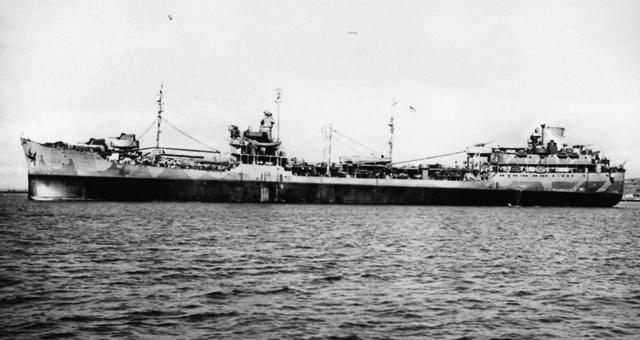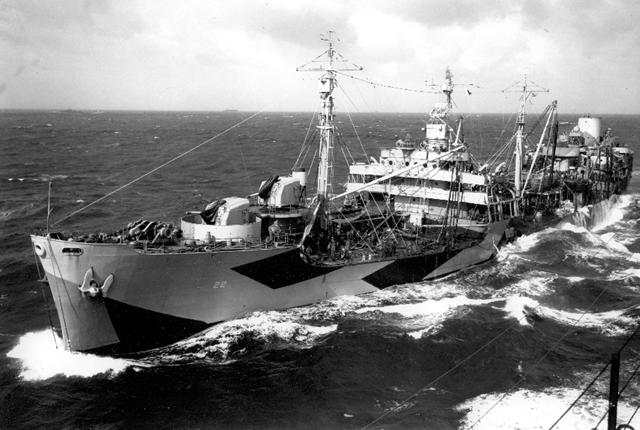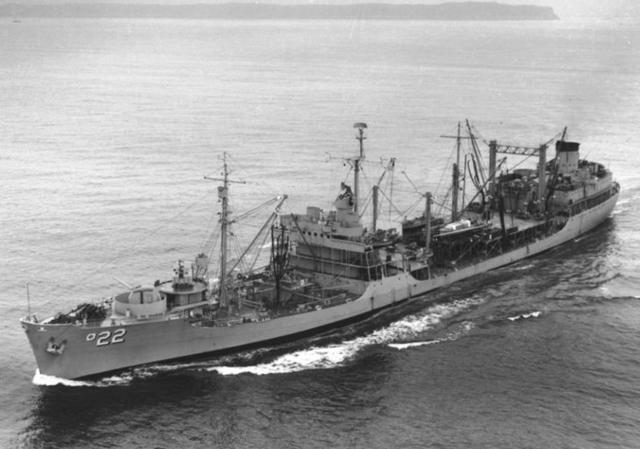January 03, 2011
The Forgotten Hero Ship
In my own personal shorthand, there is a category I call 'hero ships.' These vessels, for one reason or another, just stick in the mind as incredibly important... even if they really weren't in the grand scheme of things. Sometimes it's just because they have a cool name, sometimes it's because they seemed to be in the midst of all the action, sometimes it's because they were particularly influential. Ships like USS Enterprise, or HMS Ark Royal (the greatest name for a ship ever). The IJN Yamato is a 'hero ship,' even though it didn't do much in WWII. So are the Bismarck and the HMS Hood, fated to be forever joined on history. The doomed USS Indianapolis and USS Arizona. There are probably dozens of others in my head, ships that anybody with any knowledge of WWII have heard of.
Then there's the ship we're discussing here. Imagine if you will a vessel that was present at the following battles: the Doolittle raid; Midway; the attacks against the Solomons; Guadalcanal; New Georgia; Wake Island; the Gilbert Islands; the Marshall Islands; Truk; the Marianas battles; Luzon; the naval raids on the Japanese home islands; Iwo Jima; Okinawa; Tokyo Bay. She also just missed the Coral Sea.
And yet, nobody considers her a 'hero ship'... and they really should. For without her and her sisters, the US would have had a much harder time of it in the Pacific War.

Of course, only the truly hardcore historians pay attention to support vessels. Yet nowhere in WWII was the ability to supply the forces more important than in the vast empty spaces of the Pacific. Consider this: the distance between Berlin and Moscow is just over 1000 miles. Between the Philippines and Pearl Harbor, however, lay a distance nearly four and a half times greater. The trip between Honolulu and Tokyo is almost 4000 miles.
The USS Cimmaron (AO-22) was the namesake of the 21-strong fleet replenishment oiler type. Based on the T-3 hull, which has previously been discussed as the basis for the best of the jeep carriers, unloaded the Cimmaron only weighed about 7500 tons. When she was carrying over 100,000 barrels of Bunker C fuel oil and avgas though, she tipped the scales at around 25000 tons... nearly as much as a Yorktown-class carrier at full load.

The Cimmaron herself was put into service in March of 1939, served briefly in the Atlantic, and permanently transferred to the Pacific on April 1st, 1942. As previously mentioned, she provided fuel for carriers, cruisers, destroyers and battleships at just about every major battle until the end of WWII. Post-war, Japanese admirals and high ranking naval personnel were interviewed by the victors, and asked what was the big difference between the two navies? To a man they replied that, other than the obvious manufacturing imbalance, it was the ability to keep large fleets at sea for extended periods of time. The Cimmaron and her sisters, ships like the Neosho (the only war casualty of the type, sunk at the Coral Sea), and Chemung, the Sabine and Kaskaskia, were the primary reason ships like the Enterprise and the Saratoga and the Essex- and Independence-class carriers, and the dozens of destroyers and cruisers, were able to stay topped off as they went to work. She was honored with a place in Tokyo Bay alongside the Missouri and the other combatants when the Japanese signed the Instrument of Surrender.

But the end of WWII did not mean the end of the Cimmaron's life. After earning 10 battle stars in the Pacific War, she went on to earn another seven during the Korean War, and four campaign stars in Vietnam. In September 1968, she was the oldest ship in continuous active service in the US Navy, when she was sideswiped by the USS Hornet (CV-12) as she approached for an underway replenishment. The damage from this accident was enough to make repairs uneconomical, and she was struck from the Navy List the next month. She was sold for scrap in 1969.
Without firing a shot, the Cimmaron and other T-3 oilers surely shortened the Pacific War. If there is a better definition of a 'hero ship', I don't know what it would be.
Comments are disabled.
Post is locked.
Then there's the ship we're discussing here. Imagine if you will a vessel that was present at the following battles: the Doolittle raid; Midway; the attacks against the Solomons; Guadalcanal; New Georgia; Wake Island; the Gilbert Islands; the Marshall Islands; Truk; the Marianas battles; Luzon; the naval raids on the Japanese home islands; Iwo Jima; Okinawa; Tokyo Bay. She also just missed the Coral Sea.
And yet, nobody considers her a 'hero ship'... and they really should. For without her and her sisters, the US would have had a much harder time of it in the Pacific War.

Of course, only the truly hardcore historians pay attention to support vessels. Yet nowhere in WWII was the ability to supply the forces more important than in the vast empty spaces of the Pacific. Consider this: the distance between Berlin and Moscow is just over 1000 miles. Between the Philippines and Pearl Harbor, however, lay a distance nearly four and a half times greater. The trip between Honolulu and Tokyo is almost 4000 miles.
The USS Cimmaron (AO-22) was the namesake of the 21-strong fleet replenishment oiler type. Based on the T-3 hull, which has previously been discussed as the basis for the best of the jeep carriers, unloaded the Cimmaron only weighed about 7500 tons. When she was carrying over 100,000 barrels of Bunker C fuel oil and avgas though, she tipped the scales at around 25000 tons... nearly as much as a Yorktown-class carrier at full load.

The Cimmaron herself was put into service in March of 1939, served briefly in the Atlantic, and permanently transferred to the Pacific on April 1st, 1942. As previously mentioned, she provided fuel for carriers, cruisers, destroyers and battleships at just about every major battle until the end of WWII. Post-war, Japanese admirals and high ranking naval personnel were interviewed by the victors, and asked what was the big difference between the two navies? To a man they replied that, other than the obvious manufacturing imbalance, it was the ability to keep large fleets at sea for extended periods of time. The Cimmaron and her sisters, ships like the Neosho (the only war casualty of the type, sunk at the Coral Sea), and Chemung, the Sabine and Kaskaskia, were the primary reason ships like the Enterprise and the Saratoga and the Essex- and Independence-class carriers, and the dozens of destroyers and cruisers, were able to stay topped off as they went to work. She was honored with a place in Tokyo Bay alongside the Missouri and the other combatants when the Japanese signed the Instrument of Surrender.

But the end of WWII did not mean the end of the Cimmaron's life. After earning 10 battle stars in the Pacific War, she went on to earn another seven during the Korean War, and four campaign stars in Vietnam. In September 1968, she was the oldest ship in continuous active service in the US Navy, when she was sideswiped by the USS Hornet (CV-12) as she approached for an underway replenishment. The damage from this accident was enough to make repairs uneconomical, and she was struck from the Navy List the next month. She was sold for scrap in 1969.
Without firing a shot, the Cimmaron and other T-3 oilers surely shortened the Pacific War. If there is a better definition of a 'hero ship', I don't know what it would be.
Posted by: Wonderduck at
10:07 PM
| Comments (7)
| Add Comment
Post contains 711 words, total size 6 kb.
1
And any day during which I learn something new and interesting cannot have been a wasted day. Neat stuff, this.
Posted by: GreyDuck at January 03, 2011 11:43 PM (7lMXI)
2
I admit that when I saw your list of battles I guessed you were talking about Saratoga.
Posted by: Steven Den Beste at January 04, 2011 12:04 AM (+rSRq)
3
My first thought was the Saratoga, too. But knowing Wonderduck, I figured he'd write about something less well known, such as a seaplane tender like the Tangier. Of course it was something else. Nice post.
Posted by: Vaucanson's Duck at January 04, 2011 01:01 PM (XVJDy)
4
Well done, as usual. Thanks for continuing your articles regarding WW2 ships - you give me a viewpoint I haven't considered. But I told you that before....
Posted by: The Old Man at January 04, 2011 01:42 PM (+LRPE)
5
Thanks, Duck! Items like this are why I keep coming back.
A validation of the old maxim - logistics wins wars.
A validation of the old maxim - logistics wins wars.
Posted by: UtahMan at January 05, 2011 05:14 PM (p1tb6)
Posted by: Wonderduck at January 05, 2011 07:23 PM (JvPfH)
7
"G-dammit, boys, they're gettin away!"
-signalman on the Fanshaw Bay, scrappiest escort carrier in the Pacific Fleet, as Kurita's task force retired from Leyte Gulf
It's not true that Kurita lost the war in an afternoon - the Philippines were not a crucial theater of battle. But never did Japan come so close to winning its decisive battle than they did that day. And nothing stood between Japan's last great naval task force and the annihilation of MacArthur's forces at Leyte, except for the converted merchantmen of Taffy 3... which must have rode low in the water on account of the brass balls sported by every sailor in the group. It's one thing to win an elaborate fencing match of fleet versus fleet, but an eighteen-inch-gun battleship versus escort carriers? That's some David vs. Goliath there.
Which just goes to show. Logistics are fine and good, but logistics is fighting too, especially in a naval war...
-signalman on the Fanshaw Bay, scrappiest escort carrier in the Pacific Fleet, as Kurita's task force retired from Leyte Gulf
It's not true that Kurita lost the war in an afternoon - the Philippines were not a crucial theater of battle. But never did Japan come so close to winning its decisive battle than they did that day. And nothing stood between Japan's last great naval task force and the annihilation of MacArthur's forces at Leyte, except for the converted merchantmen of Taffy 3... which must have rode low in the water on account of the brass balls sported by every sailor in the group. It's one thing to win an elaborate fencing match of fleet versus fleet, but an eighteen-inch-gun battleship versus escort carriers? That's some David vs. Goliath there.
Which just goes to show. Logistics are fine and good, but logistics is fighting too, especially in a naval war...
Posted by: Avatar_exADV at January 06, 2011 02:29 AM (mRjOr)
24kb generated in CPU 0.0567, elapsed 0.1208 seconds.
46 queries taking 0.1119 seconds, 168 records returned.
Powered by Minx 1.1.6c-pink.
46 queries taking 0.1119 seconds, 168 records returned.
Powered by Minx 1.1.6c-pink.









